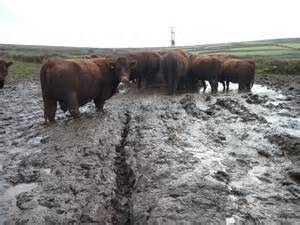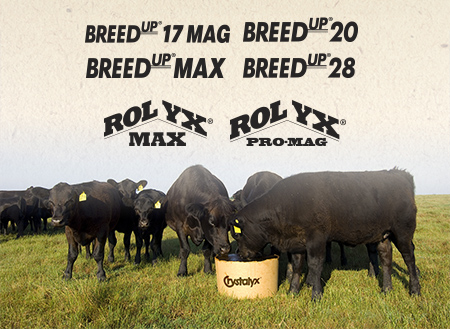In the past few years there has been a shift in the mindset of the consumer when it comes to food production. Science, it seems, is no longer an acceptable answer to the how and why of management practices. A number of retailers have taken advantage of this and have further influenced public opinion with advertising that is emotionally charged and less than 100% honest.
Prepare now to prevent the summer performance slump
In my travels this week I have seen rows of corn emerging from recently planted fields and even a few fields of mowed hay. All indication of a warm spring which will lead to summer time temperatures and the risk of reduce animal performance due to heat stress.
Keep stress at bay for healthier cattle
Stress is a natural part of life for both cattle and humans. Some stress is unavoidable, such as stress associated with calving or weaning. But other stresses can be lessened with careful management.
On a short term basis, stress isn’t a bad thing. Stress prepares an animal for a “fight or flight” response. Cortisol and epinephrine are released during a stress event. These hormones facilitate increased heart rate, mobilization of glucose for a quick burst of energy, decreased sensitivity to pain and the suppression of nonessential processes such as digestion.
Breeding programs and CRYSTALYX
The success of the CRYSTALYX® Breed-Up® family of products has been significant, and for a lot of reasons. One reason is that the Breed-Up® line provides twice the required trace minerals and vitamins for beef cattle at typical intake levels, and this makes sense to provide during the last trimester of pregnancy, and in early lactation when a cow’s nutrient requirements are the highest. Continuing a high plane of nutrition is important up to and “through the breeding season.” But just when is the breeding season through? Is it once the animal is bred; is it 45 days, 60 days? Nutrition post breeding is just as critical, if not more depending on management, types of feedstuffs/forages and/or grazing systems.
CRYSTALYX: The game changer
This may show that I watch a little too much reality TV, or, as a Friend calls it, “Far from reality TV”, but, I many times hear the phrase “this is a game changer”. People mining for gold in Alaska, may bring some new equipment or technology into play, and they proudly state, “This, is a game changer”, hoping to strike it rich.
Maximize gain in newly weaned calves with ionophores
Newly weaned, fall-born calves are full of potential; potential for amazing gains as well as health issues. Backgrounding these calves on pasture this spring can help minimize the potential for health issues, but sometimes gain can suffer. However, with proper supplementation, including an ionophore, you can maximize growth, and ultimately returns, while minimizing the risks.
An easy benchmark to remember for cow-calf producers
I recently read an internet article written by Kris Ringwall from North Dakota State University that appeared on the Drovers Cattle Network, March 30th e-newsletter. In the article Dr. Ringwall, who oversees the CHAPS beef cow-calf record system with the University, talks about a reproductive measurement that is easy to remember and so critical to defining the profitability of a cow-calf operation. The number is “60%” and it is the percentage of cows that need to have calved in the first 21 day period of the calving season. This benchmark was established using cow herds enrolled in the ND Beef Cattle Improvement Associations database and herd records spanning 2009 to 2013.
Calving season is all the time on dairy farms
Spring is just busier and more crowded!
Managing the Spring rush is associated with calving season on beef cattle operations with spring calving herds. Many dairy farms will notice a seasonal increase in calving during the spring as well. Grazing dairies will calve in the spring to match the nutrient demand with the available forage. Traditional confinement operations often see an increase in spring calving for two reasons. Many operations do not calve first calf heifers in the coldest winter months. Increased spring calving of mature cows is often a result of heat stress. Cows that fail to conceive due to the heat of July and August will often become pregnant in September. These cows will enter the dry cow pens starting in March with subsequent calving in April through June. The net result is often an overcrowded situation in the dry cow, pre-fresh and fresh pens. Overcrowding in these pens leads to increased fresh cow problems after calving, most notably ketosis and uterine infections.
Don't let mud rob you of your profits
That wonderful time between winter and spring is affectionately known as mud season for many. Mud is a very real concern for cattle producers. Muddy cattle are more likely to experience cold stress, which increases energy requirements, costing you more money and reducing profits.
Mud contributes to cold stress by decreasing the insulating properties of hair. A dry, winter hair coat has separation between the individual hairs creating a protective pocket of warm air next to the body. Mud cakes the hairs together and removes this insulating layer of air. If the mud is wet, evaporative cooling makes the cold stress just that much worse. If cattle must lie in mud, they never get a chance to dry off and the cold stress continues.
CRYSTALYX after calving: Breed-Up products continued use
Nutritionist and feed professionals like to talk a lot about pre-calving nutrition, and stress the fact that a cow’s nutrient requirements climb in the last trimester of pregnancy. This is true and good body condition matters at this time in the reproductive cycle. Still, we may get a little too caught up in this message and overlook the period between calving and breeding; the post-partum interval. In the past several years, we’ve seen a great deal of success in using the CRYSTALYX® Breed-Up® products starting 1-2 months prior to calving. Calves hit the ground healthier and more vigorously, cows clean well and all is good for cow calf, and cowboy’s alike.



